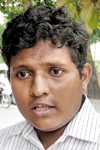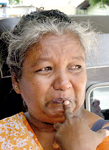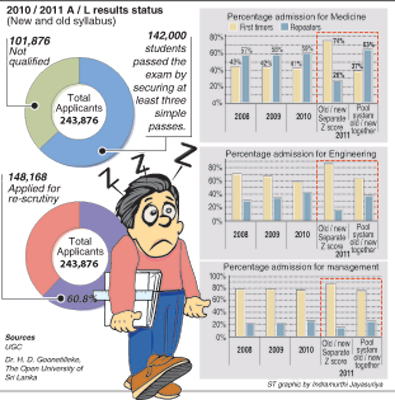Shattered hopes: Revised Z-score adds to A/Level students’ woes
By Aanya Wipulasena and Hansani Bandara | Pix by Athula Devapriya, the sunday Times
View(s):
147
The release of the revised Z-score results has given rise to a fresh controversy amidst shattered dreams for students who sat last year’s GCE Advanced level examination.
Some students who had enough Z-score points to enter university under the aborted Z-score system now find a reduction in their points after the revised Z-score results were released by education authorities following the Supreme Court order. The Supreme Court directed the authorities to scrap the earlier Z-score results, consequent to a fundamental rights petition filed by some students claiming there were anomalies in the calculation of the Z-score.

A student gives vent to her feelings at a protest held opposite the Fort on Friday. Pic by Indika Handuwala
The petitioners argued that the authorities had taken both the new and the old syllabuses as one when calculating the Z-scores. The court ordered two separate calculations – one for students who followed the old syllabus and the other for students who followed the new syllabus.
Hundreds of students this week turned up at the University Grants Commission (UGC) and the Human Rights Commission to complain that under the revised Z-score system their marks had come down.
“Is this what we get after studying and working hard for 13 years? I obtained three A passes with an Z- score of 1.8825 and I was selected to the law faculty but with the new score I can barely get in to the arts faculty,” said Maleesha Amarasekara, who ranked 39th from the Colombo District under the aborted Z-score system.
Saminda Gunawardena from Royal College, Colombo sat the exam from the bio stream and obtained an Z-score of 2.0748. He was selected to do medicine. However, his dream of becoming a doctor was shattered when the score came down to 1.9090 under the revised system.
“This is the most important exam in a student’s life and I studied hard to obtain good results. What about all those hours I spent studying late and making short notes? The officials can say anything but it is the students who have to go through the trauma,” he said.
Arts stream student Patalee Nirupamala is also in agony because she is not sure whether she will enter university. “The first time I got an Z score of 1.4008. This was sufficient to enter the arts faculty, but now with an Z-score of only 1.0680 I can’t enter any faculty. Now we are asked to prepare for the exam within a couple of weeks. I don’t think I am in a proper frame of mind to face an exam,” she said.
The shock is too much for these young students, a psychiatrist whom we contacted said. Dr. Harishchandra Gambheera warned that the Z-score shock could remain a stressful event in these students’ lives. “Up to 23 per cent of these students go through an acute stressful period and this might lead to anxiety and depression. The impact of the crisis on the students is high and there will inevitably be psychological issues,” he said.

A familiar sight now: Students gathering in front of the UGC on a daily basis. Pic by Mangala Weerasekera
However it is not just the students who are affected by the current crisis. Parents too go through untold emotional distress.
“Since childhood my son’s dream was to become an engineer and he sat the exam in the maths stream. We are now worried that he may not get selected to the engineering faculty,” lamented P. H. S. M. Piyarathne, mother of a student.
Jayarathne Hemasiri, another depressed parent from Kurunegala, said he had great hopes for his son’s education.
“I made sure that my son received the best education and sent him to tuition classes with my hard earned money. We were pleased when his Z-score was enough to secure him a seat in the university but later with all these recalculations we were disappointed that my son who got two As and a B will not be able to achieve his dream of becoming an engineer,” he said. When asked for comments, the Peradeniya University’s Senior Professor, R. O. Thattil, who introduced the Z-score system to Sri Lanka, said the problem was not in the method that was adopted to calculate the Z-score but in the decision to combine the old and new syllabuses to form one common Z-score.
“These two values cannot be combined as the old and new syllabuses are two different sets. The method ratified by the Supreme Court will be used in the future when calculating Z-score values. In other words, separate Z-scores will be issued for different syllabuses,” he said.
Meanwhile, the Higher Education Ministry has little to offer in terms of a solution to the crisis. Higher Education Minister S. B. Dissanayake, however, said the President had called for a full report on the crisis over the revised Z-score and additional 2000-3000 students will be given university admission this time.

Saminda Gunawardena
|

Patalee Nirupamala.
|

P. H. S. M. Piyarathne: Mother of a student
|
The minister said students who sat the exam under the old and the new syllabus and had obtained enough Z-score would be given university admission and they would start their first semester in October.
The Colombo University’s Senor Zoology Lecturer Deveka Weerakoon said they were willing to accommodate extra students who sat the exam under two different syllabuses, but the universities would require extra funds to function. He said the students should not be penalised for the blunder.
Education officials said students who had failed the exam or who had not received a high Z-score to enter university could sit the exam again. But students said they had only five days to reapply for the exam and less than two weeks to prepare for it.
Protests and petitions
The National Youth Front together with the University Youth Front held a protest last Thursday outside the University Grants Commission (UGC) office in Colombo.They demanded all the students whose high Z-score had come down under the revised system be granted university admission. They also demanded that the August exams be postponed so that students who wanted to sit the exam again would have time to prepare for it.
They also prepared a petition against the revised Z-score values with opposition UNP parliamentarians Akila Viraj Kariyawasam and Ruwan Wijewardena signing it.Also protesting against the revised system was the Teacher’s Association of Sri Lanka.
“It is a big injustice to the students. Ministers S.B. Dissanayake and Bandula Gunawardena who once claimed that there was nothing wrong with the results or the Z-score are silent today. The government has to take immediate action to implement a system where students will not be subjected to any injustice,” Teachers’ Association of Sri Lanka President Mahinda Jayasinghe said.
Around 250 university students representing Inter University Students’ Federation staged a demonstration outside the Fort Railway Station this week to voice their displeasure at the state of education in Sri Lanka. Dileepa Madushanka, secretary of the Students’ Union of the University of Visual and Performing Arts, said they demand a practical solution to this problem without violating the rights of the students. He also said the government should increase the budgetary allocations for education.
Students have a solution: It’s on the Facebook
Traumatised Advanced Level students have created a platform on Facebook to express their anger and grievances on the latest Z-score crisis. Here are a few comments posted by students on this Facebook page named ‘Z-score Magadiya’:� “We cannot rely on the promises of the government any more. I don’t think even the re-scrutinised results are accurate. Now they are trying to say something to console us and just get away with it”.
“There is only one solution to this issue; the authorities will have to issue separate cut off marks for old and new syllabuses and enter students to universities under the percentage of 60% from the old syllabus and 40% from the new syllabus. If UGC issues a common cut off mark for both syllabuses, whole of the student population will face an injustice”.
“Two exams, two scales, two cut-off marks, that’s what all of you should ask for”.
Related



-JAR-3.jpg)








